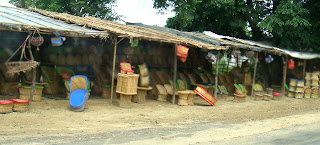Place:
GARHMUKTESHWAR
 |
| Boatmen have meagre business during most of the year except for a few holy days on the Hindu calendar |
As almost any Indian will know, if not admit, in India, religious and dirt are synonymous in the country. Whether it is that the major religious texts of the country do not stress on this aspect, or it is simply the people who do not want care, there is hardly any public place in India associated primarily with religion which is not simultaneously a garbage dump accompanied by a melee of poor.
 Garhmukteshwar
Garhmukteshwar is no exception. The closest point on the Ganga to Delhi, where those following rituals go to fulfil those obligations, it has all the failings of a religious site in India. The ghats are a short distance away from the city centre. Now there is a huge bridge that goes very near the ghats and offers great views of the ghats.
Right from the time you approach ghats, and you will have either ways taken the NH 24 to reach here, the general look of apathy and decay start.
The way to the ghats is not paved, and you often have to wade through slush mixed with cow urine, manure, sometimes human excreta, decaying fruit and vegetable droppings, little tea shops with their garbage piled right next door, so that you can check whether they have by chance used anything that might benefit your health. Never an easy experience unless you are a rural child of unruly disposition.
Then there are the shops. You have navigate through a short walkway that goes past small shacks selling a mix of religious needs - brass utensils, prayer beads, flowers, incense sticks, plastic and glass bangles, plastic toys, cups etc and plastic toy shops that cater still to the rural hinterlands. You would have to strive hard to find anything that costs Rs 100 or more. And this is pushing sale, so you may touched and told, begged, cajoled, berated into buying stuff that you would not want to be seen dead with.
The ghats here have been concretised a few years ago, and theoretically are decent. But the The river here is broad and muddy. It has already lost most of its speed after reaching the plains, though here is it generally fairly fast, and quite in torrent during the monsoons.
Garhmukteshwar is also famous for its
Ganga Fair, held in October - on the day of full moon in kartik, when it is estimated that about eight to ten lakh people take a dip in the river. This is regarded as auspicious, though exactly what good things have happened to people who have taken the dip in still unclear to me.
There is a fair amount of aquatic life, including the famous, and famously shy, river dolphins. You have to sit still in a boat in the middle of the river to catch a site of these beautiful creatures. There are a number of birds as well. The other bank of the river is largely fields, and in season ie late winter and autumn, they are lovely.
Just before the ghats are another unique offering, cane furniture. This is basic, and at prices that are a fraction of branded offerings, though more than in other unbranded places. Increasingly there are innovations happening, and this time I saw a shelf that was positively enticing. We did end up buying a few modas though for my cousins!
For me, what was most rewarding was the drive up to the place, through lush green fields and ripening crops.





